
Carved Oak Hall Bench Seat by Treede & Prenzel, 1897
A carved oak hall bench seat by Treede & Prenzel, dated 1897, in Northern Renaissance manner, the panelled back with open screen arms above the hard seat raised on scrolling trestle supports united by a low stretcher, the panel to the back carved with…

Australian Blackwood Blanket Box with Gumnut Carvings, Early 20th Century
Robert Prenzel Australian blackwood blanket box, carved with gumnuts, leaves and branches, early 20th century, ink stamp 'Toorak Road' label to base, 45 cm high, 90 cm wide, 46 cm deep

Exquisite Faunal and Floral Carved Oak Mirror Frame
A very large Faunal and floral carved oak mirror frame by Robert Prenzel, 1905-1910, a plate frame of 'Sansovino' type, the toprail with a figure of a cockatoo alighting on a crest of two overlaid escutcheons pierced by a spray of fruiting foliage and…

Robert Prenzel Oak Bookcase with Eucalyptus Carving, 1929
An oak low book-case by Robert Prenzel, 1929, the rectangular top with a low back and bevelled edge above a single cabinet door flanked by adjustable open shelves, the panelled door finely carved in relief with a spray of eucalyptus with open flowers and…
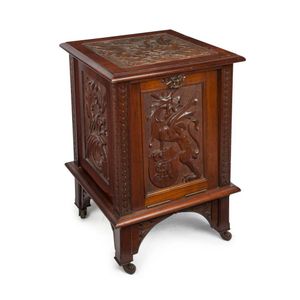
Gothic-style Blackwood Coal Scuttle with Carvings and Porcelain Castors
Robert Prenzel (attributed), a fine Tasmanian blackwood coal scuttle of generous proportions, carved in the Gothic manner with winged grotesque to the top and stylised griffin with shield initials to the hinged fall front with original tin liner,…

Carved Australian Blackwood Settle by Robert Prenzel, 1908
A carved Australian blackwood settle by Robert Prenzel, circa 1908, of rectilinear design, the panelled back and closed arms above the hinged seat enclosing a storage compartment, the back and lower part of the front each with a pair of panels finely…

Robert Prenzel Carved Blackwood Double Bed
A carved blackwood double bed by Robert Prenzel, circa 1908, of rectilinear design, the headboard with a moulded toprail above a horizontal panel finely carved in relief with sprays of flowering and fruiting eucalyptus on a stippled ground, four plain…
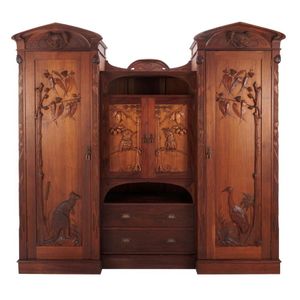
Art Nouveau Blackwood Wardrobe by Robert Prenzel, 1908
A carved Australian blackwood wardrobe by Robert Prenzel, circa 1908, of two tall cupboards enclosing hanging compartments flanking a recessed central arrangement of a smaller cupboard, drawers, and open compartments, all on a plinth base, each of the…

Robert Prenzel Carved Australian Blackwood Wash Stand
A carved Australian blackwood wash stand by Robert Prenzel, circa 1908, the rectangular marble top with a high back and an asymmetrical arrangement of a small cupboard, drawer, and open compartment below, raised on tapering square supports, the back with…

Robert Prenzel Carved Blackwood Dressing Table, Circa 1908
A carved Australian blackwood dressing table by Robert Prenzel, circa 1908, the rectangular top with a high back supporting a swinging mirror above a pair of small drawers, a pair of frieze drawers and cupboards flanking a kneehole below, on a plinth base…

Robert Prenzel Carved Blackwood Chest of Drawers
A carved Australian blackwood chest of drawers by Robert Prenzel, circa 1908, with two small cupboards flanking an open compartment and a small drawer above three long drawers, on a plinth base, the top with a low Art Nouveau style pediment back finely…

Australian Carved Timber Hall Seat with Lift-Top Storage Base
Robert Prenzel (attributed) Australian carved timber hall seat with lift-top storage base impressively carved with gumnuts and leaves, early 20th century 123 cm high, 115 cm wide, 55 cm deep

Treede & Prenzel Blackwood Corner Cabinet with Carvings
Robert Prenzel (Treede & Prenzel) fine Australian blackwood wall mounted corner cabinet with beautifully carved panel doors and unusual pivot hinge drawer, early 20th century stamped 'Treede & Prenzel, Sturt Street, South Melbourne' 140 cm high, 84 cm…

Gumnut Carved Maple Centre Table
Robert Prenzel centre table, Queensland maple with carved gumnuts, leaves, blossoms and branches on four sides, early 20th century, 74 cm high, 92 cm wide, 58 cm deep

Robert Prenzel Kookaburra Chest
A Robert Prenzel chest, Robert Prenzel (1866-1941). C.1910. The relief carved panel to the front depicting a kookaburra on a leaf baring eucalyptus branch. The hinged lid with original brass fixings. Stamped to underside of box 'Robt Prenzel/Toorak Road, …
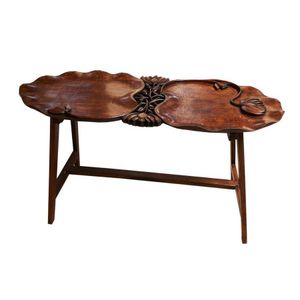
Arts & Crafts Water Lily Table
After Robert Prenzel (Australian, 1866-1941), Arts & Crafts occasional table, c. 1910, probably black bean, the top carved with water lilies flanked by two large leaves, height 60 cm width 114 cm depth 50 cm
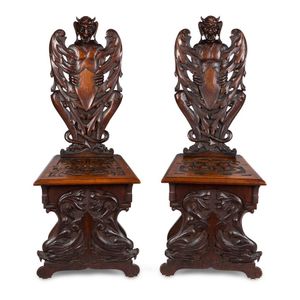
Gothic Renaissance Blackwood Hall Chairs by Robert Prenzel
Robert Prenzel (1866-1941), a pair of blackwood carved hall chairs, in Gothic Renaissance style, the back panels depicting winged demons each holding a shield. The solid wood seats carved with Art Nouveau flowers set upon a base carved with dolphins.…
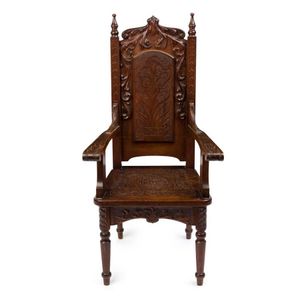
Robert Prenzel Carver Chair with Orchid Carvings
School of Robert Prenzel carver chair, blackwood, early 20th century decorated with carved orchids monogram and dated 'E.Y.C. 6th Sept. 1904' 53 cm across the handles

Australian Blackwood Bookcase with Carved Gum Leaves
An early 20th century Australian blackwood dwarf bookcase, in the manner of Prenzel, the frieze carved with foliate decoration, above open shelves flanked by panelled doors, each carved with gum leaves and foliate, 139 cm high, 148 cm wide, 45 cm deep

Gothic Renaissance Blackwood Settle, Dated 1903
Robert Prenzel (1866-1941) an important blackwood settle, dated 1903, the high back with and corbels at each end, above three panels, each finely carved in the Gothic Renaissance style, the outside left and right panels carved with Gryphons and inscribed…
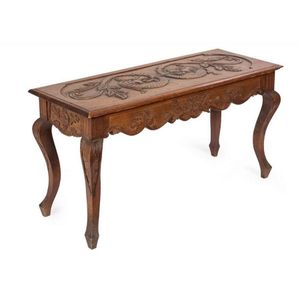
Prenzel's Griffins: Australian Blackwood Occasional Table
School of Robert Prenzel occasional table carved with griffins, Australian blackwood circa 1915. 48 cm high, 92 cm wide, 35 cm deep

Mountain Ash Kookaburra Fire Screen
Robert Prenzel (1866-1941) Mountain Ash fire screen, circa 1910, central panel depicting two kookaburras perched on gum nut branch, carved with a waratah motif, framing the two top edges, 87 x 76 cm

Blackwood Art Nouveau Pedestal by Robert Prenzel
Australian Art Nouveau carved blackwood pedestal from the workshop of Robert Prenzel. Height 117 cm, width 33 cm, depth 33 cm

Antique Blackwood Settle with Carvings and Latin Inscription
Robert Prenzel (1866-1941), a blackwood settle, circa 1904-1909 the rectangular back inscribed with the Latin motto Pax Huic Domui - Peace be to this house - above a gryphon frieze, stylised scroll arms and a hinged seat, the front and sides carved with…
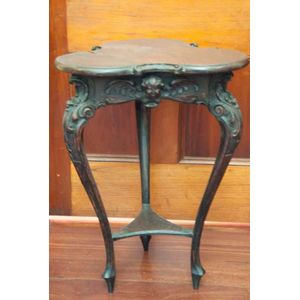
Carved Oak Table by Treede & Prenzel
A rare carved oak occasional table by Robert Prenzel and Johann Treede, Australian, late 19th/early 20th century, signed ‘Treede & Prenzel, Sturt St., S.M, Europ. labor’. 72 cm high

Blackwood Prenzel-style Overmantle Mirror with Intricate Carvings
Heavily carved blackwood overmantle mirror in Prenzel style
 Loading more...
Loading more...